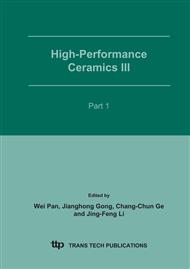[1]
Z.G. Zhou, Z.L. Tang, Z.T. Zhang, et al.: Sensors and Actuators B Vol. 77(2001), p.22.
Google Scholar
[2]
T. Zilong, T. Xiaofeng, Z. Zhigang, et al.: J. Chin. Ceram. Soc. Vol. 30 (2002), p.57.
Google Scholar
[3]
A. Abragam and B. Bleaney: Electron Paramagnetic Resonance of Transition Ions (Claredon, Oxford, 1970).
Google Scholar
[4]
G. E. Pake and T. L. Estle: The Physical Principles of Electron Paramagnetic Resonance, (Benjamin Reading, Mass., 1973).
Google Scholar
[5]
C. Qian, Y. Li, X.F. Tang, et al.: J. Inorg. Mater. Vol. 16 (2001), p.732.
Google Scholar
[6]
S. S. Eaton and G. T. Eaton: Bull. Mag. Res. Vol. 1(1979), p.130.
Google Scholar
[7]
R. Scharfschwerdt, A. Mazur, O.F. Schirmer, et al.: Phys. Rev. B Vol. 54 (1996), p.15284.
Google Scholar
[8]
P. Murugaraj and T. R. N. Kutty: Mater. Res. Bull. Vol. 20 (1985), p.1473.
Google Scholar
[9]
B. Milsch: Phys. Stat. Solid. A Vol. 133 (1992), p.455.
Google Scholar
[10]
H. Ikushima and S. Hayakawa: J. Phy. Soc. Jap. Vol. 19 (1964), p.1986; Vol. 20 (1965), p.1517.
Google Scholar
[11]
H. Ikushima: J. Phys. Soc. Jpn. Vol. 21 (1966), p.1866; Vol. 27 (1969), p.414.
Google Scholar
[12]
A. Abragam and B. Bleaney:, Electron Paramagnetic Resonance of Transition Ions, (Clarendon Press, Oxford, 1970).
Google Scholar
[13]
F.E. Mabbs and D. Collison, Electron Paramagnetic Resonance of d Transition Metal Compounds, (Elsevier, 1992).
Google Scholar
[14]
M. Karplus and R. N. Porter: Atoms & Molecules, (Benjamin, 1970).
Google Scholar
[15]
T. R. N. Kutty, P. Murugaraj and N. S. Gajbhiye: Mater. Lett. Vol. 2 (1984), p.396; Mat. Res. Bull. Vol. 20 (1985), p.565.
Google Scholar
[16]
K. A. Muller, W. Berlinger and K.W. Blazey: Solid State Commun. Vol. 61 (1987), p.21.
Google Scholar
[17]
G. H. Anderson: Phys. Rev. Vol. 120 (1960), p.1606.
Google Scholar
[18]
J. H. Lee, S. H. Kim and S. H. Cho: J. Amer. Ceram. Soc. Vol. 78 (1995), p.2845.
Google Scholar
[19]
T. Kolodiazhnyi and A. Petric: J. Phys. Chem. Solids Vol. 64 (2003), p.953.
Google Scholar


